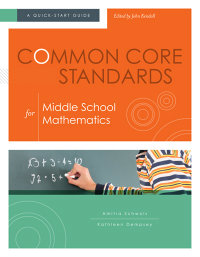Must-Have CCSS Math Guide
Common Core Standards For Middle School Mathematics: A Quick-Start Guide
By Amitra Schwols and Kathleen Dempsey (Series Editor: John Kendall)
(ASCD and McREL, 2013 – Learn more)
Common Core Standards for Middle School Mathematics is considered a quick start guide. I would agree!
On one hand the text provides clear and concise information that can be scanned quickly to affirm a novice teacher’s understanding. At the same time, experienced teachers like myself will find the information thought- provoking as we carefully read the text and apply it to our own personal experiences.
After teaching 6th grade math for over 12 years, I am shifting to an advanced 7th grade math position where I will incorporate both the 7th and 8th grade standards. I have found many relevant points in Common Core Standards to connect and consider as I plan the upcoming school year’s units of instruction.
What’s Inside?

In the introductory chapter, the eight Standards for Mathematical Practice are reviewed. According to the authors, each domain has specific mathematical practices, which naturally align with the content. Personally, I plan to make a chart of their recommendations to utilize as I plan to introduce and apply the practices in my daily lessons.
Next, each of domains has a chapter dedicated to a more thorough understanding of the core standards. By organizing each chapter into two sections, “Connections to the Standards for Mathematical Practice” and “Conceptual Pathway Through the Grades,” the authors provide a consistent structure. The middle school domains include:
- Ratios and Proportional Relationships
- The Number System
- Expressions and Equations
- Functions
- Geometry
- Statistics and Probability
The conceptual pathways section provides an analysis of each domain’s content clusters both within and across grades. Each chapter begins with a simple but effective overview of how (once the CCSS is fully implemented) students will have been prepared in earlier grades to begin instruction at the middle level. I truly had a feeling for the learning journey that the Common Core designers have plotted out for students.
The chapters continue with an analysis of the cluster/s for each of the middle level grades (6-8). The authors provide a very concise description of the standards with application examples at each grade. Through the analysis I have a more clear understanding of the scope and sequence across the entire span of middle school mathematics instruction.
The Gold Mine: Integrating the Core with Best Practices
Finally, the gold mine! Often as an educator I have attended professional development sessions that describe a method or standard, only to become frustrated because the presenter never gets to the “how.” As a practicing teacher, I can read about the ”what” — the things I need most are suggestions of “how.” I want models that integrate the new concepts — models I can analyze and consider before tweaking for my own style and my particular students’ needs. This book does that!
The final chapters recommend the use of the nine instructional strategies from Classroom Instruction That Works, 2nd Edition (Dean et al., 2012). Many teachers will be familiar with these strategies, often referred to as (Robert) Marzano’s Best Practices. Our district implemented these strategies over 10 years ago. As a lead math teacher in my system, I have presented to educators in our district and at several workshops in Illinois encouraging the implementation of these strategies into daily instruction.
This section of the book begins with a brief tutorial on designing lesson plans using three best-practice components: creating the environment for learning; helping students develop understanding; and helping students extend and apply knowledge. The authors include a step by step lesson plan process and offer three detailed sample lesson plans with clear explanations and rationale. Read, dig in, reflect, and find your own stride as you review:
- Understanding Statistical Questions and Describing Data (Grade 6)
- Proportional Relationships (Grade 7)
- Transformation and Congruent Figures (Grade 8)
Whether you’re looking for a quick skim and scan read or looking for a text to stimulate thinking and reflection about your current teaching practices, the authors have been succeeded in meeting your needs. I highly recommend this text as you prepare for instruction integrating the Common Core Standards and the best practices of instruction.
Read another MiddleWeb review of this book by math teacher Kathy Felt.
Rebecca Anderson has been an educator for over 16 years in Illinois, serving as a gifted education teacher and a differentiated learning consultant for grades K-8. As a district leader she has chaired action teams, served on district leadership committees, and provided training/workshops on Marzano’s Best Practices, both in her district and statewide. Rebecca has a Masters in Elementary Education with an emphasis in gifted education from Western Illinois University.































